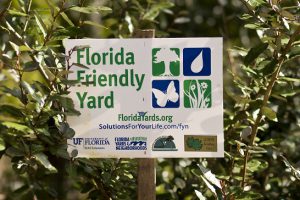What is rain water harvesting? Have you ever wondered how you can utilize our rain water? Last Water Wednesday, the Florida-Friendly Landscaping Agent in Seminole County, Tina McIntyre, went through the basics of a rain barrel. To read more Tina McIntyre’s blogs, please visit: https://blogs.ifas.ufl.edu/seminoleco/author/kmcintyre/
Florida-Friendly Landscaping

Before we dive into the rain barrel basics, let’s review what Florida-Friendly Landscaping is. The Florida-Friendly Landscaping (FFL) program is a partnership between the University of Florida IFAS Extension and the Florida Department of Environmental Protection. The program is in the Florida law and focuses on the nine FFL principles. The FFL program is really a water quality and quantity program that looks to both conserve and protect the water of our state. Lawns can be large users of water and producers of pollutants so that is where education efforts are focused.
The nine principles include:
- Right plant right place
- Water efficiently
- Mulch
- Fertilize appropriately
- Recycle yard waste
- Attract wildlife
- Control yard pests responsibly
- Reduce stormwater runoff
- Protect the waterfront
Rain Barrels

We all live in a watershed. When it rains, that water runs off into our lakes, rivers, and streams, or percolates down into our aquifer. All the water we use that comes from the aquifer, which is a finite amount. We need to take measures to protect it. One way to do that is to install a rain barrel!
The benefits of a rain barrel include:
- Reduces need for irrigation from well or municipal source
- Saves YOU money
- Rain can be better for the more sensitive plants like orchids
- Prevents erosion
- Provides water during droughts
- Improves local water quality
- Reduces rain runoff including pollution and flooding
Rain Water Usage on Edible Plants
When irrigating with a rain barrel some caution should be used when irrigating edibles. Specifically avoid watering edible plants if you have an old tar and gravel roof, old asbestos shingle roofs, treated wood shingle, a copper roof or if you have a zinc anti-moss strip. Also, pay attention to the type of gutters you have, since some may be coated with lead-based paints.
Many residents with an asphalt shingle roof avoid watering vegetables since complex hydrocarbons may be leached from the roof; however, there is no definitive research to prove the extent of the leaching. If you have an asphalt shingle roof and will be using a rain barrel, make sure to clean the barrel with a 3% bleach solution before collecting water to irrigate a vegetable/herb garden.
Household, unscented bleach with a 5–6% chlorine solution can be added at the rate of 1/8 teaspoon (8 drops) of bleach per gallon of water. A typical 55-gallon rain barrel would need approximately one ounce (2 tablespoons) of bleach added on a monthly basis. During periods of frequent rainfall, bimonthly treatment may be necessary. Wait approximately 24 hours after the addition of bleach to allow the chlorine to dissipate before using the water. Note that household bleach is not labeled for use in water treatment by the Food and Drug Administration although it is frequently recommended for emergency disinfection of drinking water (USEPA, 2006).
In short, if your roof fits the above qualifications:
- Bleach the water
- Irrigate at sunrise
- Water at the roots
- Dump the first flush
For more information on the U.S. Environmental Protection Agency research, please visit: https://www.sightline.org/2015/02/18/advice-on-rain-barrel-watering-now-as-a-pamphlet/
Here to watch the Water Wednesday recording:
 0
0
